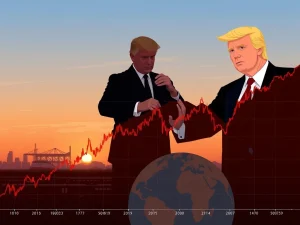Bitcoin Price Drops: Why the US-China Trade Deal Sent Shockwaves Through Crypto

Many investors were left scratching their heads recently when the Bitcoin price took an unexpected dip, especially right after positive news broke about the US China trade deal. Stocks soared, and gold dropped, which seemed logical, but Bitcoin’s reaction puzzled many. Let’s dive into the factors behind this surprising market movement.
Understanding the Bitcoin Price Reaction to the US-China Trade Deal
Bitcoin had been on a strong upward trend, reaching a significant high point before the news hit. However, instead of continuing its climb alongside the rallying stock market, it pulled back. This temporary easing of tensions in the US China trade deal conflict involved a 90-day truce on import tariffs and discussions around critical issues like currency manipulation and trade practices. While this development is clearly positive for businesses and traditional markets, its immediate effect on scarce digital assets like Bitcoin appeared counterintuitive to some.
How Macroeconomic Factors Influenced the Crypto Market Analysis
The primary driver behind Bitcoin’s recent weakness near the $105,000 level appears to be a shift in broader macroeconomic conditions. The trade truce signaled reduced global economic uncertainty, leading investors to pivot away from traditional safe-haven assets. Gold, for instance, saw a notable decline as demand for such assets decreased. Simultaneously, the US Dollar Index (DXY) strengthened, reaching a 30-day high. This strengthening dollar often reflects increased investor confidence, which can sometimes draw capital away from alternative assets like cryptocurrencies. Our Crypto market analysis suggests this macroeconomic pivot played a significant role.
Exploring Bitcoin Correlation with Traditional Assets
While Bitcoin often moves independently, its relationship with traditional markets, particularly stocks, has been noteworthy. Bitcoin had already experienced substantial gains (around 24%) in the 30 days prior to the trade deal news, significantly outpacing both the S&P 500 (which rose about 7%) and gold (which remained flat). With such a strong recent performance, investors saw less immediate reason for Bitcoin to continue diverging sharply upward, especially given its relatively high Bitcoin correlation with the stock market, which stood at 83% over the 30-day period. The trade deal directly benefits companies whose stocks are traded, making them a more obvious immediate target for capital seeking returns from the news.
The Growing Influence of Institutional Crypto Holdings
The market also digested news about significant Institutional crypto accumulation. MicroStrategy, for example, added another substantial amount of BTC. Combined with BlackRock, institutional entities now hold a significant percentage of Bitcoin’s circulating supply. While some express concern that this concentration could make the market vulnerable if these large holders were forced to sell, particularly MicroStrategy due to its debt strategy, the company has significantly increased its capacity to raise capital through stock and debt offerings, making a forced sell-off scenario less likely in the short term. Furthermore, the considerable inflows into US spot Bitcoin ETFs (around $2 billion in early May) demonstrate robust institutional demand. This steady inflow points towards adoption driven by institutions rather than speculative retail FOMO, which is fundamentally a positive long-term signal for the asset, even if short-term price movements are influenced by macro shifts and profit-taking.
Summary: Navigating the Post-Trade Deal Landscape
The recent dip in Bitcoin price following the positive US China trade deal news highlights the complex interplay between macroeconomic events, traditional markets, and cryptocurrencies. The sell-off wasn’t a sign of weakness inherent to Bitcoin, but rather a reaction to investors shifting capital towards assets deemed to be direct beneficiaries of the trade truce, coupled with some potential profit-taking after recent strong gains. The high Bitcoin correlation with stocks played a part, as did the broader macroeconomic environment favoring confidence over safe havens. Despite this short-term pullback, the continued strong inflows into Institutional crypto products like ETFs remain a compelling positive indicator for Bitcoin’s long-term trajectory, suggesting underlying demand remains robust even as market dynamics cause temporary price fluctuations. Understanding this context is key to navigating the current Crypto market analysis.








